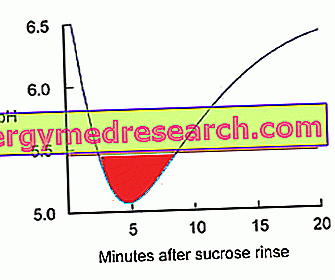Generality
Meningitis is an inflammation of the meninges, the membranes that enclose and protect the brain and spinal cord. The fulminant form of this pathology is rare, but extremely serious, and can have lethal consequences.

Fulminant meningitis is generally of bacterial origin. CSF testing is often useful for etiological diagnosis.
What's this
Fulminant meningitis is an inflammatory process that affects the membranes that surround the brain and spinal cord ( meninges ).
The function of these three membranes (pious mother, arachnoid and dura mater) is to protect the central nervous system from infections. When a pathogen threatens this area, the dura mater (the outermost meninge) becomes more permeable, so as to allow a greater flow of white blood cells (cells responsible for defending the body from the attack of bacteria, viruses and fungi from the 'external). However, this immune reaction determines the inflammation of the membranes themselves. The result is edema formation (ie an accumulation of fluids) and increased intracranial pressure, with poor tissue oxygenation and risk of brain damage.
The fulminant form occurs in a small percentage of all cases of bacterial meningitis, which can be contracted at any age.
The most feared infectious agent is meningococcus ( Neisseria meningitidis ), of which there are several serotypes (currently, 13 are known, but only 5 - A, B, C, Y, W135 and X - are clinically relevant, as they can cause epidemics and diseases that are dangerous for humans).
In Italy, meningococcus C is the most aggressive serotype and is found most frequently along with strain B.
Note
Usually, meningitis recognizes an infectious cause (viral, bacterial or fungal), but there are also forms caused by irritative phenomena (eg drugs, neoplastic infiltration from primary brain tumors or metastases, physical injuries etc.) and some systemic diseases ( as sarcoidosis and vasculitis).
Causes
Many bacteria can cause fulminant meningitis.
In general, the microorganisms responsible for the pathology are invasive (that is, capable of multiplying rapidly and spreading throughout the body) and vary with the age of the patient:
- In the newborn, the main etiological agents are Escherichia Coli and group B streptococci;
- In the adolescent and young adult, the bacterium Neisseria meningitidis (meningococcus) is more commonly implicated, of which there are several serogroups (A, B, C, Y, W135 and X);
- In the elderly, cases are mainly due to Streptococcus pneumoniae (pneumococcus) and Listeria monocytogenes .
Among the agents that can cause fulminant meningitis, hemophilic B or Hib ( Haemophilus influenzae type b) should also be mentioned.
How the infection develops
The meninges are normally sterile and represent a warm and nutrient-rich environment, therefore ideal for the colonization of pathogenic micro-organisms coming from the outside (such as in the case of penetrating traumas, skull fractures or neurosurgical maneuvers) or adjacent foci of infection (eg otitis, sinusitis and pneumonia). In the latter case, special circumstances are necessary, such as the lowering of the immune system or the presence of other diseases (eg tuberculosis, measles, rubella, chicken pox, etc.), which allow pathogens to reach the meninges through the blood and the cerebro-spinal fluid (or liquor, that is the fluid that permeates and protects the brain and spinal cord).
The incubation period of meningitis varies between 3 and 4 days, but can be extended up to 10 days (maximum time provided for health surveillance).
The underlying pathophysiology remains poorly understood, but it was found that, in the case of fulminant meningitis, inflammatory cells infiltrate leptomeninges (arachnoid and pia mater, ie the meninges closest to the brain surface) and the wall of the meningeal blood vessels, the which appear congested and dilated. Inflammation can then spread to the brain parenchyma or ventricles. Starting from the areas of greatest accumulation, pus striae can branch off along the blood vessels on the brain surface.
How it is transmitted
Everyone can get meningitis, but young children and adolescents are more likely to get the infection caused by different types of meningococcus . The elderly, those suffering from immune deficiencies and other chronic diseases are also at risk.
Transmission of infective meningitis occurs after prolonged and close contact with people with the disease or healthy carriers. The infection can occur by air (using droplets of saliva and dispersed nasal secretions, talking, coughing or sneezing) or through the direct contact of biological fluids (eg drinking from the same glass or eating with the same cutlery as a person who has contracted the disease).
However, in order for the infection to occur it is necessary to be in close and prolonged contact with the infected person or to be in very crowded environments. Exposure to the causative agents does not necessarily lead to the development of fulminant meningitis: in fact, the state of carrier is frequent, that is of a completely asymptomatic and transient healthy individual, which does not develop the disease.
Symptoms and complications
Fulminant meningitis begins with generic and non-specific symptoms, which can be misleading, such as:
- Headache;
- fatigue;
- Drowsiness;
- Loss of appetite;
- Nausea and vomit.
However, more characteristic symptoms appear on these manifestations, which should never be ignored:
- Neck and neck stiffness;
- High fever;
- Petechiae (small reddish or purple spots due to micro-hemorrhage of the vessels);
- Strong weakness and prostration;
- Stiffness to leg extension;
- Photophobia (sensitivity of the eyes to light);
- Alteration of the level of consciousness;
- Tremors and convulsions.
In infants and small children, the disease may present with more nuanced signs, such as lack of appetite, acute crying, pale color, irritability and a steady gaze.
Warning! Fulminant meningitis is characterized by a sudden onset and rapid deterioration of the general state of health.
In some cases, fulminant meningitis can also lead to death within a short time. Other times, the disease has serious, debilitating and permanent consequences, especially if the diagnosis (and the beginning of the appropriate therapeutic treatment) has not been sufficiently timely.
The most frequent consequences of fulminant meningitis include:
- Brain damage;
- Deafness;
- Epilepsy;
- Permanent blindness or partial visual impairment (caused by intracranial pressure fluctuations);
- Motor paralysis;
- Intellectual difficulties or mental retardation;
- Damage to the kidneys and adrenal glands.
Fulminant meningitis can also lead to limb amputation or the presence of scars caused by infection.
In 5-20% of cases, in addition to meningitis, some bacteria can reach the blood and cause sepsis, which is a generalized infection. This condition is recognized by the sudden appearance of fever and red spots on the skin (petechiae), often associated with hypotension and shock.
Diagnosis
In case of suspected meningitis, the doctors carry out some specific tests, such as taking a sample of the cerebral spinal fluid through a lumbar puncture (ie placing a needle in the lower back, through the spine). This analysis allows the culture test of the liquor, in which the biological samples are sown on a laboratory plate and thus allow to verify the possible growth of the bacterium. The analysis of cerebro-spinal fluid is useful to assess, therefore, if there is infection and, if so, if it is a virus or a bacterium that causes it.
The diagnosis of fulminant meningitis is confirmed by molecular biology tests to identify traces of DNA from the bacterium in the human body.
Therapy
Fulminant meningitis is an example of an aberrant host response to infection, which resists available medical intervention. In fact, during the pathology, cerebral edema cannot be predicted and the use of additional techniques to control it has not been shown to modify the onset of intracranial hypertension. Even the latter condition is often refractory to treatment.
However, the therapeutic approach of fulminant meningitis is conditioned by the causal agent and the age of the patient. Meningococcal meningitis should be managed promptly, for example, in hospital settings, with massive doses of intravenous antibiotics.
Clearly, the intervention is more effective if the agent causing the disease is identified, both to guide the patient's antibiotic therapy and to define the need for contact prophylaxis.
In all cases, the treatment must be started as early as possible to avoid serious permanent outcomes (deafness, loss of one or more limbs, visual disturbances, neuro-motor deficits) or death.
Prognosis
Fulminant meningitis is an extremely serious disease and can result in death within a few hours (24-48 hours after the onset of symptoms), despite the timely administration of specific antibiotics.
Prevention
Fulminant meningitis can be prevented by vaccination .
This measure allows, in fact, to reduce the risk of developing the main invasive bacterial forms of the disease and counter the spread of infection, since it promotes the induction of an immune memory and the formation of antibodies that defend the body.
At present, to prevent meningitis, meningococcal vaccines in their monovalent (C and B) or tetravalent (AC-W135-Y) formulation are the most effective tool to protect against the disease in a lasting way, reducing the risk of a course severe with debilitating or even lethal results.
Furthermore, vaccines are available to protect against the forms of fulminate meningitis caused by:
- Hemophilus B : the vaccine is included in the hexavalent vaccine (which also offers protection against diphtheria-tetanus-pertussis, poliomyelitis and hepatitis B), whose first dose is given as early as the 61st day of life (third month).
- Pneumococcus : a vaccine is available, practicable from the first months of life, which protects from 13 different strains of Streptococcus pneumoniae .
Other useful precautions against fulminant meningitis
The bacteria that cause fulminant meningitis, particularly meningococcus, cannot live long outside the human body and are very sensitive to common disinfectants, temperature changes and drying. In other words, the disease is transmitted less easily than a cold or flu.
Being the inter-human contagion, the risk of contracting meningitis can be reduced by implementing some measures of personal hygiene and protection:
- Avoid closed and crowded places, and close contact with people;
- Do not exchange objects for personal use (glasses, cutlery, cigarettes, soft non-washable toys, etc.);
- Keep the surfaces that may be contaminated clean (switches, telephones, keyboards, handles, faucets, elevator control panels, tables and desks);
- Ventilate the rooms where people live and work often, especially if the premises are very busy (barracks, kindergartens, schools, etc.);
- Wash your hands carefully and several times a day with soap and water, especially after coughing or sneezing.



